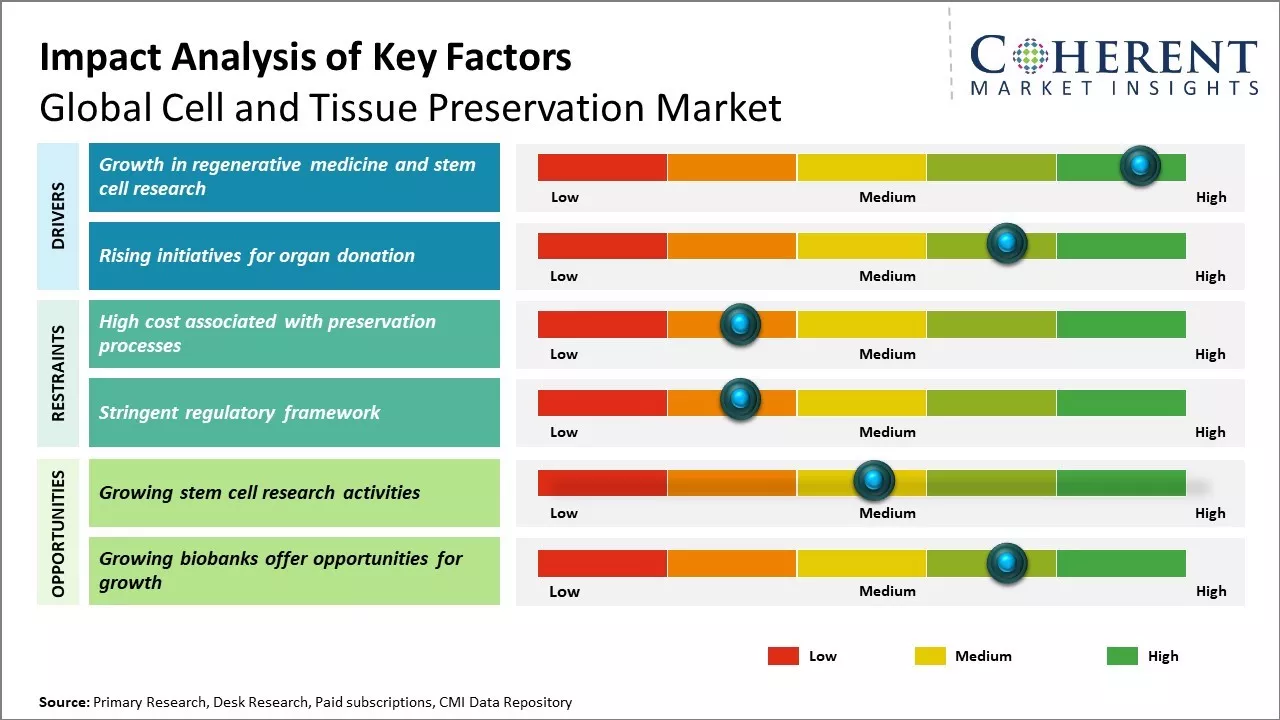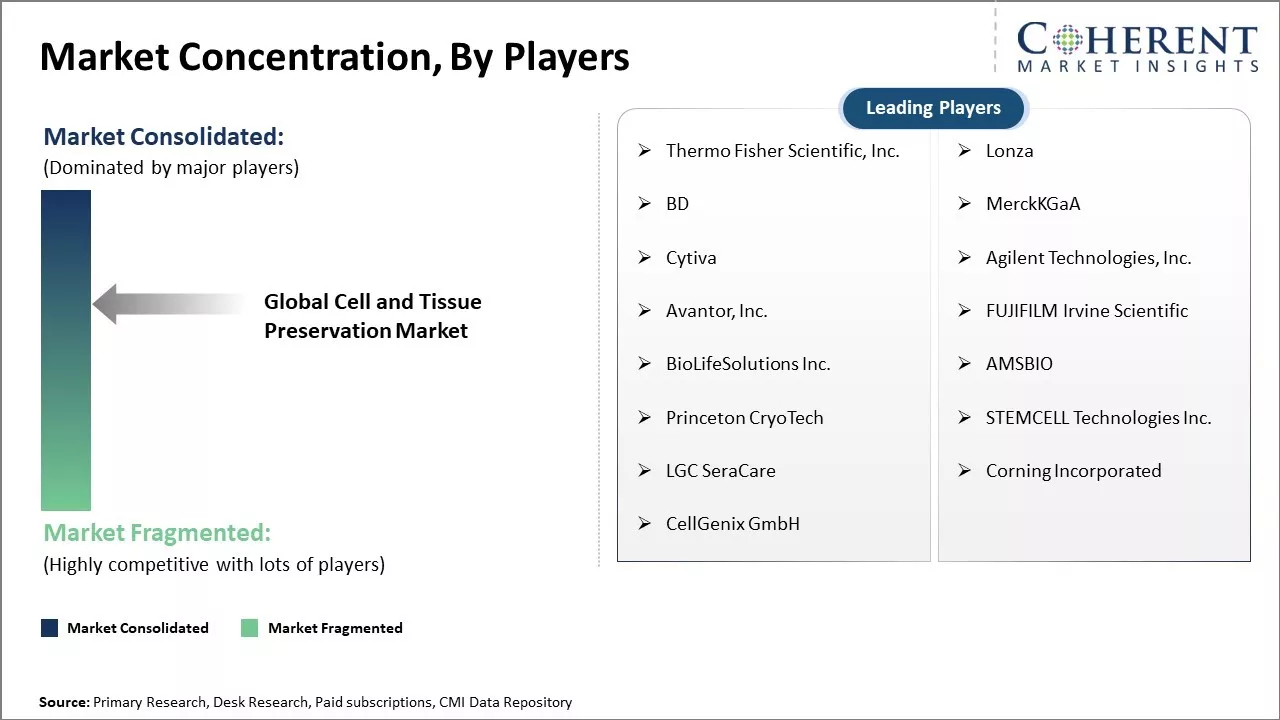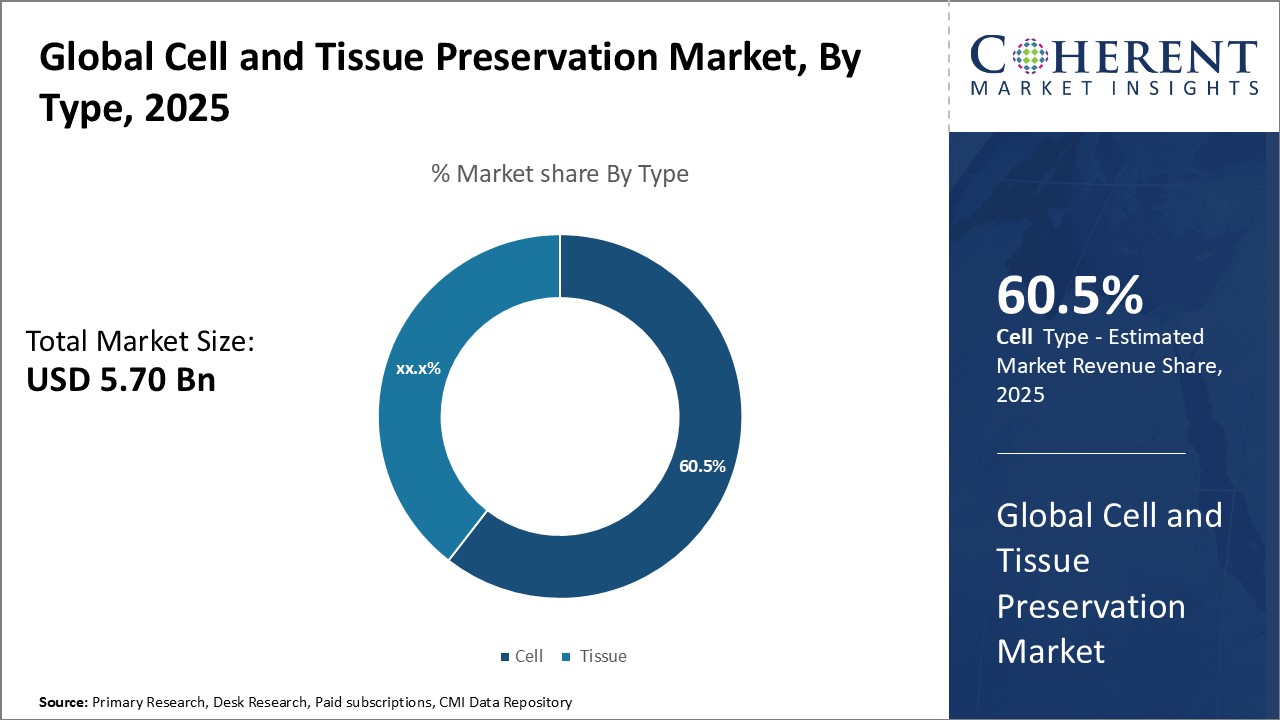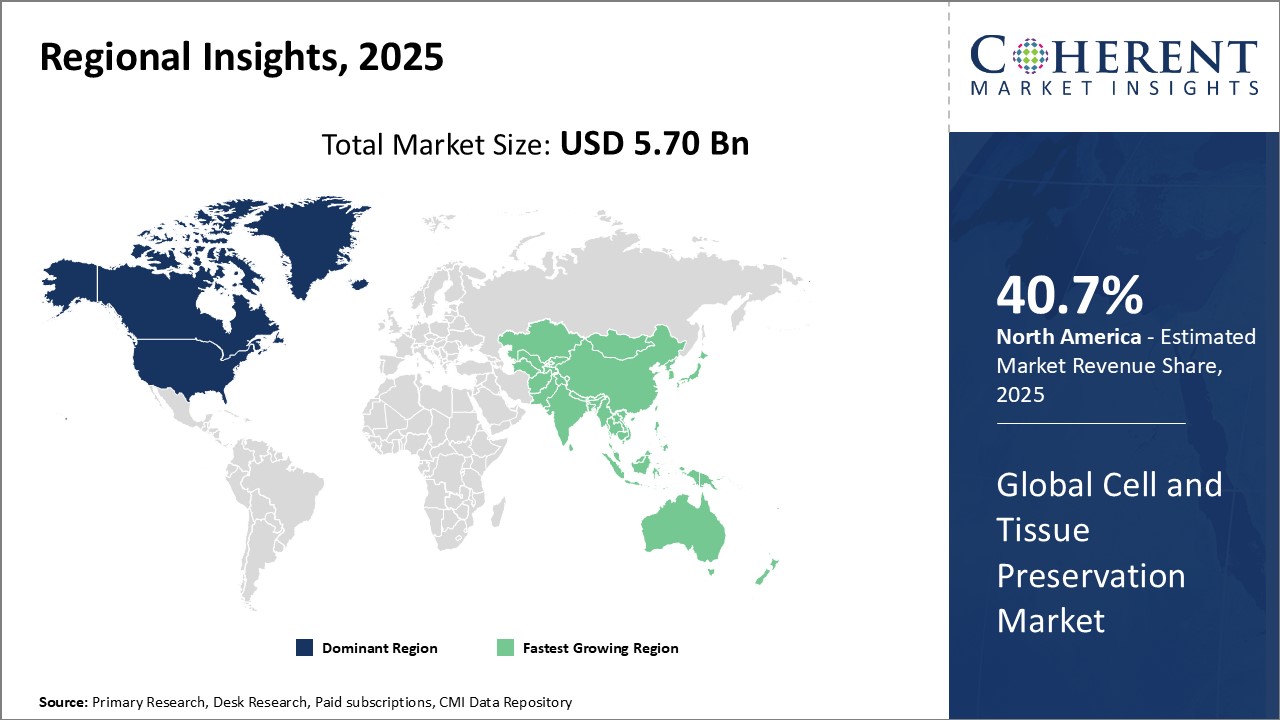Global Cell And Tissue Preservation Market Size and Trends
Global cell and tissue preservation market is estimated to be valued at USD 5.70 Bn in 2025 and is expected to reach USD 12.22 Bn by 2032, exhibiting a compound annual growth rate (CAGR) of 11.5% from 2025 to 2032. Growing investment in stem cell and cancer research from both public and private sectors boosts focus on the development of advanced cell and tissue preservation techniques. Access to funding helps finance clinical research as well as the development of innovative biomaterials and cryopreservation solutions.

Discover market dynamics shaping the industry: Download Free Sample
The market growth is driven by increasing demand for biomaterials used for cell and tissue preservation. Key players are investing in research and development to introduce new biomaterials with improved bio stability and cryoprotective properties. Long term preservation of stem cells, organoids, and other complex tissues is an area of active research. Customized preservation media tailored for specific cell and tissue types can better address the need for high viability post-thaw.
Market Driver – Growth in regenerative medicine and stem cell research
Regenerative medicine and stem cell research offers tremendous potential for developing new treatments and ultimately cures for debilitating diseases. There has been immense progress in people’s understanding of how stem cells can be used to regenerate tissues and repair organs. This progress is fuelled by ongoing research in both academic institutions and biotech companies seeking to translate fundamental discoveries into novel therapies. The promise of regenerative medicine to treat conditions previously considered incurable captures public imagination and raising hopes worldwide. Several stem cell therapies are already in clinical trials or approved for certain applications. Hematopoietic stem cell transplantation is routinely used for blood cancers. Research is advancing on using mesenchymal stem cells to treat conditions such as cardiovascular disease and osteoarthritis by stimulating the body's innate healing responses. Other trials are exploring embryonic and induced pluripotent stem cells to develop cell replacement therapies for diseases like macular degeneration, Parkinson's, diabetes and spinal cord injuries. For regenerative medicine to become reality on a larger scale, overcoming technical challenges in stem cell processing, storage and delivery will be critical. Reliable methods are needed for isolating different stem cell types from source material like cord blood, embryonic or adult tissue in a regulated manner. Once isolated, cells must remain viable and functional after long-term preservation and storage, often in cryogenic conditions. Finally, standardized processes are required to administer the preserved cells with good engraftment and clinical outcomes. Rapid advances in cell and tissue preservation techniques can facilitate the translation of promising stem cell research into viable therapies.
Market Concentration and Competitive Landscape

Get actionable strategies to beat competition: Download Free Sample
Rising initiatives for organ donation
Increasing awareness and initiatives regarding organ donation can drive the global cell and tissue preservation market growth. With more people donating organs after their death, there has been huge demand for preserving tissues and cells for future transplantation purposes. Several government and non-profit organizations across the world have started campaigns to educate people about the dire need for organ donation and importance of cell and tissue banking. For instance, according to the data from the U.S. Department of Health and Human Services, over 106,000 people in the U.S. were on the waiting list for organ transplantation as of 2023, while every 10 minutes a new name is added to this list. Due to shortage of donor organs, thousands of people lose their lives each year while waiting. At the same time, according to Eurotransplant International Foundation, over 8,200 organ transplants were coordinated by Eurotransplant in 2021, showing a year-on-year increase of 4.5%. Rising donation and transplantation has propelled the need for effective preservation solutions to store tissues and cells for future use. Global cell and tissue preservation market growth is driven by favorable regulatory environment encouraging organ donation in several regions. Growing public-private initiatives to promote organ donation programs and build infrastructure for tissue banking increases confidence in this life-saving medical practice. While North America currently dominates due to high healthcare investments and availability of advanced technologies, Asia Pacific is likely to offer lucrative opportunities owing to growing medical tourism and increasing healthcare expenditures in the region.
Key Takeaways from Analyst:
Global cell and tissue preservation market growth is driven by rising investments in regenerative medicine research, increasing stem cell therapy applications and technology advancements in preservation techniques. However, high installation and maintenance costs of advanced equipment can hamper the market growth.
North America currently dominates the market, owing to strong research funding and presence of leading industry players. Asia Pacific is expected to be the fastest growing region due to rising healthcare expenditure, increasing population, and growing economy.
Stem cell preservation segment will witness the highest growth as stem cell therapies have huge potential in treating various diseases. Countries like China and India can offer lucrative opportunities for major players to expand their presence in the region.
From technique perspective, vitrification-based preservation will gain more popularity as compared to slow freezing method as it causes minimum damage to tissues during cryopreservation process. Increased research activities in areas such as cancer, neurodegenerative diseases and personalized medicine can boost demand for cell and tissue preservation solutions. Leading players need to focus on developing advanced tools to meet precision requirements of regenerative medicine applications. Strategic collaborations with research institutes and hospitals can help companies gain higher market share.
Market Challenges: High cost associated with preservation processes
The high costs associated with cell and tissue preservation processes can hamper the global cell and tissue preservation market growth. Cell and tissue preservation requires specialized equipment, facilities, media and reagents that are usually expensive. For instance, cryogenic freezers that are able to maintain ultra-low temperatures for long-term cell and tissue storage can cost hundreds of thousands of dollars alone. Freezing media, cryoprotectants and other consumables needed on a regular basis increases recurring costs. Maintaining cell banks and biorepositories also incurs high operating expenses related to liquid nitrogen, equipment maintenance, quality control testing and skilled labor. Given the expense of setting up and sustaining cell and tissue preservation infrastructure, many smaller research institutes and labs find it difficult to justify the investment. This hampers widespread experimentation and commercialization of new cell- and tissue-based therapies, limiting the scope of applications that can boost demand. Even large pharmaceutical and biotech companies may shy away from projects that require preserving large numbers of primary cell types due to budgetary constraints. The high costs disproportionately impact non-profit efforts related to developing countries where budgets for health research are limited. For example, according to the data from the United Nations Educational, Scientific and Cultural Organization (UNESCO), African countries spent only 0.5% of their GDP on research and development in 2020, much lower than the global average of 2.2%.
Market Opportunities: Growing stem cell research activities
Increasing research activities in stem cell therapy can offer opportunity for the global cell and tissue preservation market growth. Stem cell research holds promise for a wide range of future medical applications in regenerative medicine involving the treatment of diseases such as cancer, diabetes, cardiac disorders and neurodegenerative conditions. As scientists continue advancing stem cell isolation techniques and our understanding of how stem cells can be manipulated to regenerate specific cell types in the body, there will be a growing need to preserve large numbers of clinically-relevant stem cell lines and tissues. Stem cell banking is accelerating globally as more families elect to privately store umbilical cord blood stem cells for future medical or therapeutic use by family members. According to the World Marrow Donor Association, over 35 million stem cell transplants have been registered worldwide between 1974 and 2021. This demonstrates an immense interest in preserving lives through stem cell therapies and transplantation. As research progresses, stem cell banking is likely to expand beyond just cord blood to involve tissue-specific stem cells and induced pluripotent stem cells. The ability to bank and preserve diverse stem cell sources under optimal conditions will be pivotal to enable the full potential of personalized regenerative therapies. Furthermore, with emerging cell and gene therapy applications, researchers will require reliable access to preserved stem cell product sourced from diverse population backgrounds. For example, clinical trials are ongoing to evaluate the use of chimeric antigen receptor T cell therapy (CAR T-cell) to treat blood cancers using a patient's own immunological cells. Ensuring access to preserved human tissues facilitating such advancement remains essential. According to the World Health Organization, over 18.1 million new cancer cases and 9.6 million cancer deaths were reported globally in 2020. The gradual shift towards less invasive cell and immunotherapies for cancer and other diseases can offer opportunities for cell and tissue preservation market players.

Discover high revenue pocket segments and roadmap to it: Download Free Sample
By Type- Advances in Cell Therapy Drives Cell Segment Growth
By type, cell segment is estimated to contribute the highest market share with 60.5% in 2025, due to growth in cell-based therapy development. Rapid progress is being made in developing new cell therapies to treat various chronic and genetic diseases. In particular, immunotherapy using chimeric antigen receptor T-cells (CAR-T) has emerged as a breakthrough in cancer treatment. Notable clinical successes with CAR-T therapies such as Kymriah and Yescarta have validated the potential of this approach. This has boosted investment and research activity aimed at engineering new CAR-T therapies and expanding approved indications. Developments continue in mesenchymal stem cell therapies which show promise for regenerative applications in orthopedics and wound healing. Several mesenchymal stem cell products have received regulatory approval or are in late-stage trials. The commercialization of these therapies will require robust and reliable cell manufacturing capabilities supported by effective cell preservation techniques. As more cell therapy candidates enter clinical validation and advanced trials, significant cell volumes must be produced, transported, and stored over long time periods while maintaining viability and other quality attributes. This growing demand leads to increased adoption of automated cell processing systems, cryopreservation methods and cold chain logistics among clinical and commercial cell therapy developers. Aside from new therapies, optimization of existing cell-based procedures such as hematopoietic stem cell transplantation also relies on advancements in cell handling and preservation. Improving post-thaw viability and functionality of stored hematopoietic stem cells can expand donor pools and transplantation success rates. Rapid therapeutic progress in cell therapy development and commercialization can drive the cell segment growth.
By Product- Equipment Dominance Driven by Automation and Standardization Needs
By product, equipment segment is estimated to contribute the highest market share with 45.5% in 2025, due to growing need for automation and standardization in processing and preservation workflows. As cell therapy development intensifies, manual methods of cell handling can no longer adequately meet demands for quality, scale, and reproducibility. Research and clinical organizations are increasingly adopting automated workflows incorporating robotic liquid handling platforms, centrifugation equipment, microfluidics, and integrated cold storage systems. These systems offer advantages such as walkaway processing, closed sampling, traceability, and standardized protocols that improve cell therapy manufacturing efficiency and compliance with emerging cell therapy guidelines. Automated equipment allows for more precise control over critical processing parameters such as spin speeds, temperatures, and reagent mixing, thus, yielding more consistent post-thaw cell viabilities. These are also easily validated and produce electronic batch records for auditing. Advanced equipment integrated with online monitoring systems provides real-time data on critical process parameters and storage tank conditions. This boosts process understanding, comparability between batches, and continuous process verification as required for commercial-scale cell therapy manufacturing. Equipment is also capable of cryogen-free liquid nitrogen storage which enhances workplace safety over manual storage methods. As cell therapy translational activity escalates globally, regulatory agencies are placing greater emphasis on demonstrated product and process consistency, data integrity, and traceability.
By Application- Drug Discovery Dominates By application, drug discovery segment is estimated to contribute the highest market share with 52.5% in 2025, due to extensive reliance on preserved biomaterials in the drug development process. Throughout all phases of drug R&D including target identification, screening, toxicity testing and clinical research - conserved cells and tissues serve as essential tools and models. For example, in target validation hundreds of preserved cell lines from various tissues are screened to characterize gene functions and identify potential drug targets. Biobanks maintaining vast repositories of preserved primary cells, cell lines and tissue slices are critical resources supporting target discovery. Secondary drug screening also depends heavily on panel assays leveraging preserved cells. Further downstream, tissue slices and 3D organoids preserved via various methods enable predictive toxicology studies, absorption distribution metabolism and excretion profiling to aid candidate selection. Clinical research also banks biospecimens from thousands of subjects involved in trials for correlating response to biomarkers. Cell and tissue preservation is integral to biobanking efforts powering all stages of modern drug R&D.
Regional Insights

Need a Different Region or Segment? Download Free Sample
North America dominates the global cell and tissue preservation market with an estimated market share of 40.7% in 2025, owing to strong healthcare infrastructure and high adoption of advanced technologies in the region. The presence of leading life sciences research companies and large biopharma players has ensured perpetual innovations and demand for cell and tissue preservation solutions. Furthermore, significant funding from both public and private sectors for medical research activities involving cell therapies, regenerative medicines and tissue engineering can drive the market growth. With major markets like the U.S. and Canada hosting top medical schools and research institutes, North America remains the hub for trailblazing researches using preserved biomaterials.
Asia Pacific has emerged as the fastest growing regional market for cell and tissue preservation in recent years. Rapid economic expansion, growing healthcare expenditure and rising patient awareness in Asia Pacific can drive the market growth. China, Japan and India have demonstrated strong focus on developing their healthcare infrastructure as well as life sciences industry. This has lured many international preservation solution providers to set up manufacturing units and research facilities in Asia to capture the business opportunities. Governments across Asia are introducing favorable regulations and incentives to encourage local bioscience startups and boost medical tourism. As a result, Asian countries are fast emerging as strategic sourcing destinations for various preserved biomaterials.
Market Report Scope
Global Cell and Tissue Preservation Market Report Coverage
| Report Coverage | Details | ||
|---|---|---|---|
| Base Year: | 2024 | Market Size in 2025: | USD 5.70 Bn |
| Historical Data for: | 2020 To 2024 | Forecast Period: | 2025 To 2032 |
| Forecast Period 2025 to 2032 CAGR: | 11.5% | 2032 Value Projection: | USD 12.22 Bn |
| Geographies covered: |
|
||
| Segments covered: |
|
||
| Companies covered: |
Thermo Fisher Scientific, Inc., Lonza, BD, MerckKGaA, Cytiva, Agilent Technologies, Inc., Avantor, Inc., FUJIFILM Irvine Scientific, BioLifeSolutions Inc., AMSBIO, Princeton CryoTech, STEMCELL Technologies Inc., LGC SeraCare, Corning Incorporated, CellGenix GmbH |
||
| Growth Drivers: |
|
||
| Restraints & Challenges: |
|
||
Uncover macros and micros vetted on 75+ parameters: Get instant access to report
Market Segmentation
- Type Insights (Revenue, USD Bn, 2020 - 2032)
- Cell
- Mammalian Cells
- Others (Microorganisms and Plant Cells)
- Tissue
- Blood
- Bone
- Soft Tissues
- Skin
- Others
- Cell
- Product Insights (Revenue, USD Bn, 2020 - 2032)
- Equipments
- Kits & Reagents
- Freezers & Refrigerators
- Storage Systems
- Others
- Software
- Bio-preservation Media
- Home-brew Media
- Pre-formulated Media
- Equipments
- Application Insights (Revenue, USD Bn, 2020 - 2032)
- Therapeutics
- Drug Discovery
- Gene therapy
- IVF treatment
- Cell therapy
- Research & Development
- End User Insights (Revenue, USD Bn, 2020 - 2032)
- Biobanks & Cell banks
- Hospitals & Diagnostics Labs
- Research Laboratories
- Others
- Preservation Technique Insights (Revenue, USD Bn, 2020 - 2032)
- Cryopreservation
- Ambient Temperature Storage
- Temperature-controlled Storage
- Drying / Freeze-Drying
- Radiation
- Others
- Regional Insights (Revenue, USD Bn, 2020 - 2032)
- North America
- U.S.
- Canada
- Latin America
- Brazil
- Argentina
- Mexico
- Rest of Latin America
- Europe
- Germany
- U.K.
- Spain
- France
- Italy
- Russia
- Rest of Europe
- Asia Pacific
- China
- India
- Japan
- Australia
- South Korea
- ASEAN
- Rest of Asia Pacific
- Middle East
- GCC Countries
- Israel
- Rest of Middle East
- Africa
- South Africa
- North Africa
- Central Africa
- North America
- Key Players Insights
- Thermo Fisher Scientific, Inc.
- Lonza
- BD
- MerckKGaA
- Cytiva
- Agilent Technologies, Inc.
- Avantor, Inc.
- FUJIFILM Irvine Scientific
- BioLifeSolutions Inc.
- AMSBIO
- Princeton CryoTech
- STEMCELL Technologies Inc.
- LGC SeraCare
- Corning Incorporated
- CellGenix GmbH
Share
Share
About Author
Abhijeet Kale is a results-driven management consultant with five years of specialized experience in the biotech and clinical diagnostics sectors. With a strong background in scientific research and business strategy, Abhijeet helps organizations identify potential revenue pockets, and in turn helping clients with market entry strategies. He assists clients in developing robust strategies for navigating FDA and EMA requirements.
Missing comfort of reading report in your local language? Find your preferred language :
Transform your Strategy with Exclusive Trending Reports :
Frequently Asked Questions
EXISTING CLIENTELE
Joining thousands of companies around the world committed to making the Excellent Business Solutions.
View All Our Clients
